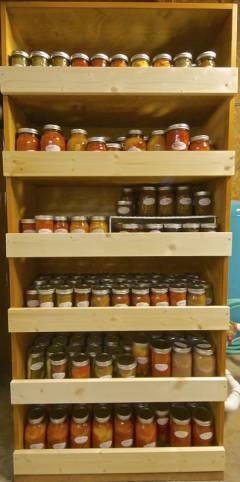Table of Contents
Growing tomatoes
History
Attempts at growing tomatoes in 2012 and 2013, our first here in the Pacific Northwest, weren't encouraging at all. In 2012 we had limited space in a hoop house. We grew some tomatoes, but late season blight took its toll.
In 2013 we had unlimited space in Fall City and attempted to grow 40 plants in several varieties, but mainly paste tomatoes. For reasons that are obvious now, but weren't then, we lost 85% of the tomatoes to late season blight.
For 2014 we knew that either we quit trying to grow tomatoes or we “got serious.” We chose to do the latter by building a hoop house where we intended to grow tomatoes and several varieties of peppers.
Hoop house
You can read about development of the hoop house elsewhere in this wiki. For now, on with the tomato saga.
Clay soil (ugh!)
As I was loosening the soil in the hoop house before transplanting tomato seedlings, I noticed how packed and dense it was. But I kept on digging. As a regular practice I added my home-made compost as I went. During this time I decided to do a physical soil test (see the piece about soil tests). I found the soil in the tomato beds was 90%+ clay, that means very little sand and silt - VERY little.
Clay soil plusses
There are a couple (well at least one) good things about clay soil:
- Retains moisture and wicks it to plants throughout the season.
- Ummmm.
Clay soil minuses
Some not-so-great things about clay soil are:
- It holds on to soil nutrients and makes it difficult for plants to get what they need.
- It provides a welcome home for root-eating symphylans who thrive in rich, moist soils.
- It becomes waterlogged in local winter rains.
Steve Solomom recommends drastic measures to work with this level of clay concentration, but here I was ready to transplant and running late already.
Extreme measures
But I took from his recommendations what I could use in these circumstances.
- Full measure of compost
- Regular balanced organic fertilizer with triple the lime
- Initial foliar application of Epsom salts (contains magnesium and calcium)
- Regular foliar application of fish-based fertilizer (a 0.5% solution about every 10 days through August)
I ended the spraying when it appeared plant leaves were staying too moist.
Fertilizing
At first the transplants were pale and weak. We realized that in this heavy clay soil roots need more calcium and magnesium than in sandy loam. The initial spraying of Epsom salts followed by regular spraying of a fish emulsion fertilizer really made a difference in the vigor of the plants.
Watering
Because of the high water table and the wicking property of the clay we watered very little, even though the rain doesn't get directly to the soil inside the hoop house. When we transplanted to the hoop house the water table was within feet of the surface.
In July and August we watered no more than four times, and as tomatoes ripened through September we quit watering.
We got results!
 We filled our canning shelves on the 26th of September. So we're through canning tomatoes for sure.
We filled our canning shelves on the 26th of September. So we're through canning tomatoes for sure.
We canned a total of 75 quarts (equivalent) of tomatoes, plus xx jars of salsa and xx jars of tomato relish. These numbers don't include the xx pints of peaches canned from a bulk purchase, strawberry jam, and several items left over from last year: pickles, beets, apple pie filling, apple butter, and blackberry, raspberry, and grape jelly.
Hmmm. What shall we grow next year?
